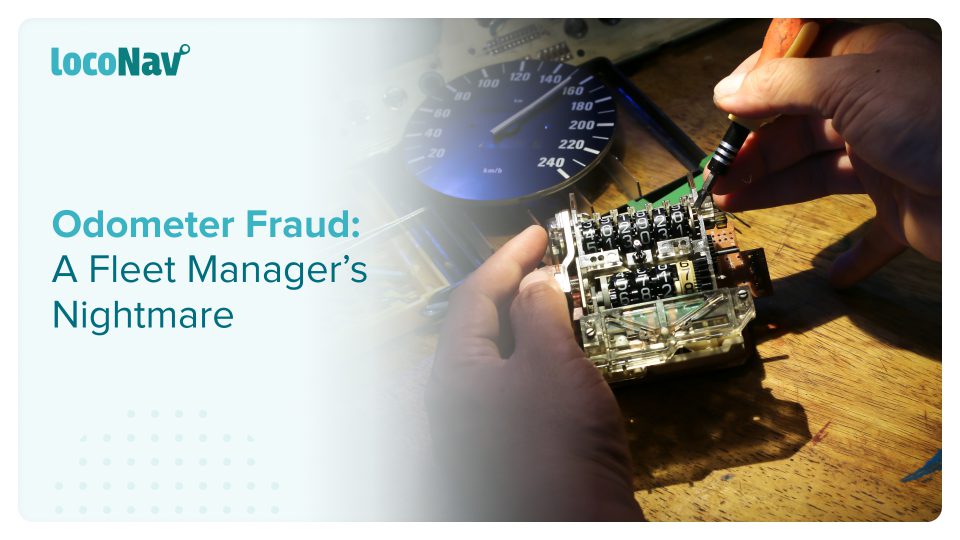

Odometer readings are one of the most important data sources in fleet management. Not only does having precise odometer readings assist ensure that preventative maintenance is kept up to date (resulting in a safe fleet), but it also gives accurate vehicle worth and lifespan stage data for right-sizing. Odometer fraud is an unfortunate yet frequently occurring practice in commercial fleet vehicles.
Having precise and updated odometer data allows you to evaluate the value of the vehicle and decide when and if you should sell it. Keeping an aging fleet past its optimal financial lifespan might result in expenditures ranging from costly maintenance to increased fuel consumption and, ultimately, decreased utilization.
In this blog, we will outline what an odometer is, what odometer fraud is, how odometers are important to fleet management, and how fleet managers ensure optimum odometer readings.
Manage your fleet efficiently with LocoNav’s Fleet Management Solutions!
What is an Odometer in Vehicles?
The odometer in a vehicle is most likely the least understood but most obvious component. If you go out and question any random automobile owner about the odometer, he or she may not even be aware of it. The odometer, positioned under the steering wheel on the dashboard, displays the mileage traveled by the vehicle.
An automobile odometer keeps track of how far a vehicle has traveled. The distance traveled by a vehicle is used for a variety of purposes. The odometer is used to measure the mileage of your vehicle. Odometer fraud is therefore done to manipulate the mileage of the vehicle.
How Important are Odometer Readings to Fleet Managers?
Correct odometer readings assist fleet managers in
- determining when to replace or dispose of vehicles
- execute maintenance jobs and clean vehicles
- rotate vehicles to various regions of the organization
- detecting fuel fraud
- accurately charging vehicle usage
- making a range of other fleet management decisions.
Odometer readings are an important aspect of a fuel and logistics management policy for fleet managers who are concerned with fuel usage and journey times. Odometer fraud hinders fleet efficiency.
What Happens When a Driver Tampers with the Odometer?
While every manager in the used vehicle market looks for vehicles that have been driven less frequently, meter manipulation has become a very popular practice in the industry. As a vigilant fleet manager, you should avoid odometer fraud.
Odometer fraud is the illegal practice of lowering an odometer reading to make it appear that a vehicle has traveled shorter distances than it actually has. This is a dishonest operation that affects vehicle prices and leads the consumer to believe he is buying a vehicle with fewer kilometers on it.
In this blog, we will discuss the indications of odometer fraud:
- Tampering with the mileage would necessitate removing the instrument from the dashboard and rolling back the digit gears. There are various visible tampering indicators that are commonly observed, making detection quite simple.
- Examine the dashboard for physical indicators such as scratches, an uncomfortably fitted dashboard, and misaligned odometer digits.
- Scammers may overlook the vehicle control module, but mileage is also logged on this. Modifying the odometer does not always have an effect on the control module. A mechanic might readily check for mileage irregularities.
How can a Fleet Manager Ensure Accurate Reporting of an Odometer?
Unfortunately, odometer fraud is a frequent activity, primarily in the transportation business. Fleet owners are aware of the situation but frequently lack sufficient evidence to face the delinquent drivers or operators.
The introduction of sophisticated GPS-enabled fleet management systems, on the other hand, has catapulted the automotive industry into the age of information through the use of onboard vehicle telematics, sensors, connected intelligence, and data analytics (etc).
In other words, it is the fusion of wireless comms, position, and in-vehicle electronics based on data traveling to and from automobiles over wireless networks.
ELD (Electronic Logging Device): often known as “Black Boxes,” are installed in vehicles and can track, record, and communicate a vast amount of data to centralized fleet management software. This information can also be exchanged via cell phone.
FAQ
What is the difference between an odometer and a speedometer?
The odometer is a device that measures the distance traveled by a vehicle, whereas the speedometer measures the speed of a vehicle.
Can you adjust an odometer?
Yes. Any odometer, including digital ones, can be adjusted or altered. Digital odometer fraud requires specialized tools that leave no trace. Scammers will either change the display numbers or replace the memory chip with one that has fewer kilometers on it.
What does a high odometer reading mean?
Mileage is only one measure of how well a vehicle is maintained. In theory, a vehicle with more miles has greater wear and tear, however, a car with 60,000 miles on the odometer can be in poorer condition than one with 120,000 miles. A high odometer reading may very well mean that the vehicle has been driven for a longer period of time and has good maintenance.